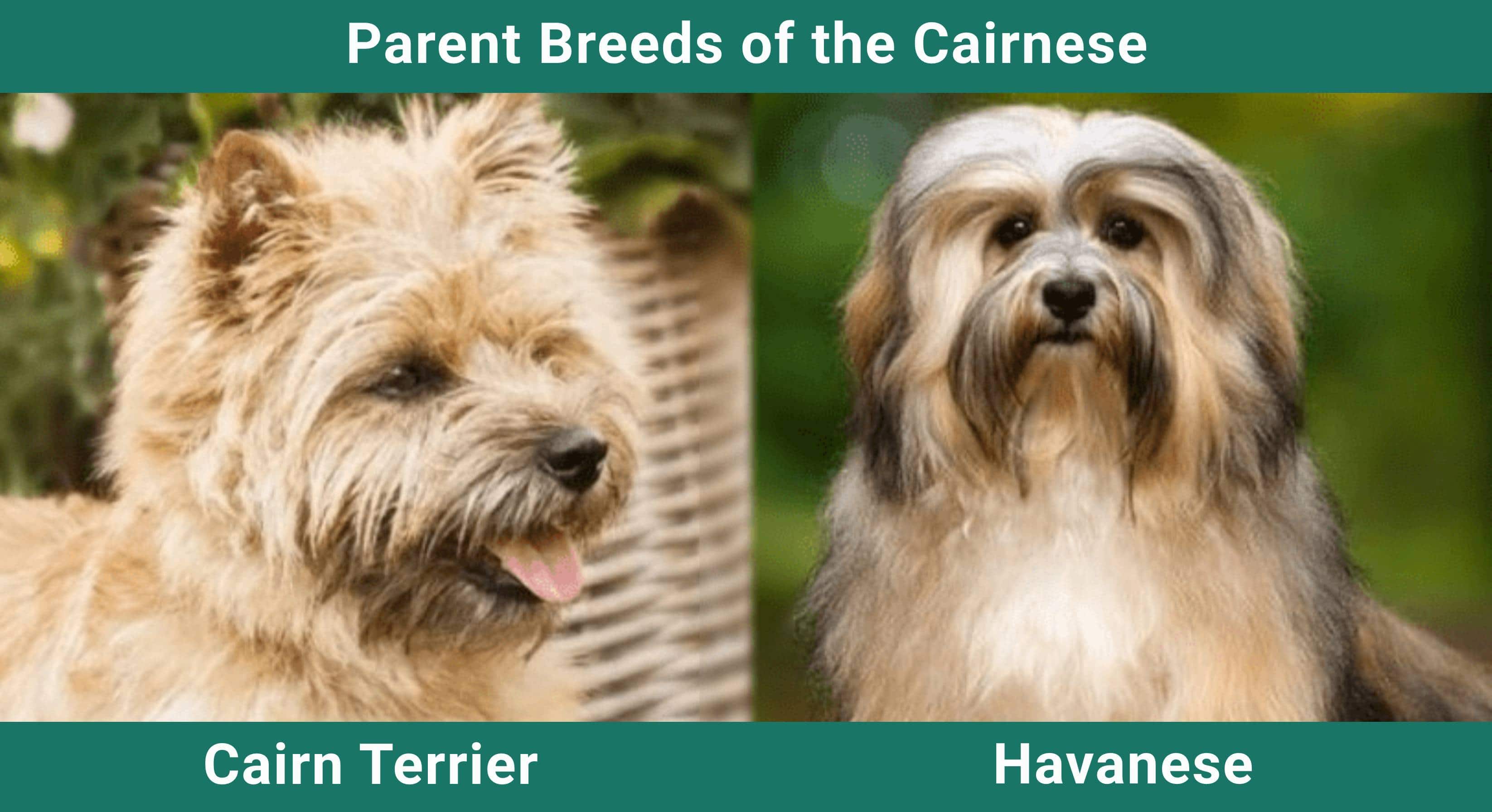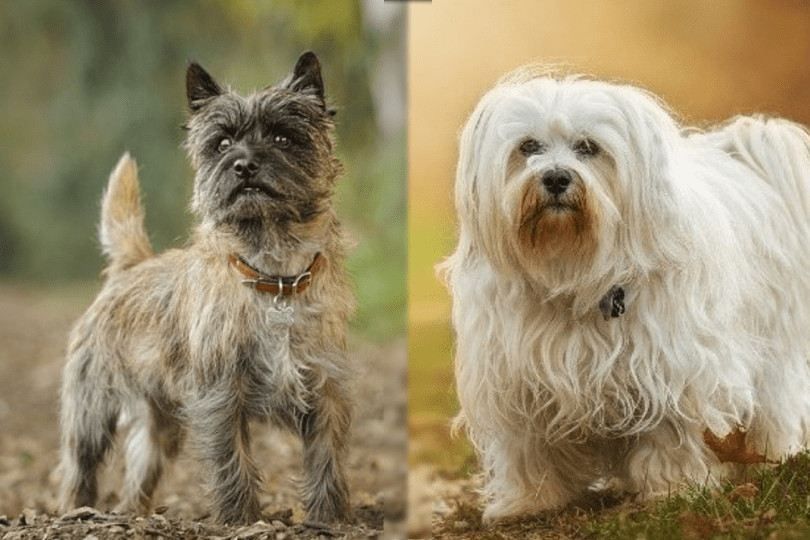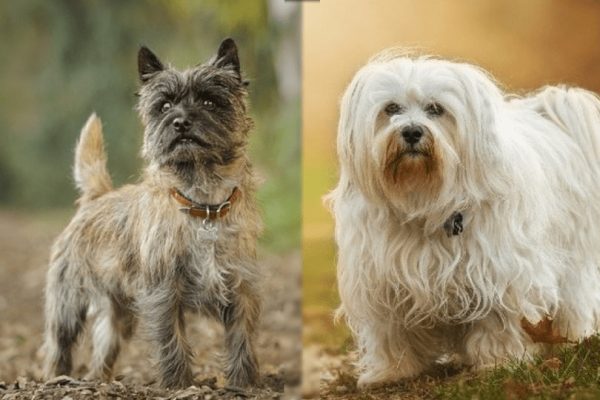Click Below to Skip Ahead
The Cairnese is a rather small designer dog breed that was first created in the 1990s. It’s a cross between the somewhat rare Havanese breed from Cuba and the Cairn Terrier. Energetic but friendly dogs, Cairnese make great companions and family pets, though they do tend to have a bit of a prey drive that means you’ll have to be careful of other small pets. Because of their relatively small size, Cairnese make great dogs for apartment living; their exercise needs are easy to meet, even without a yard.
Breed Overview
Height:
8 – 13 inches
Weight:
10 – 20 pounds
Lifespan:
12 – 15 years
Colors:
Tan, brown, black, white, fawn, gray
Suitable for:
Families and individuals willing to include their dog in activities
Temperament:
Affectionate, loving, stubborn, energetic, friendly, independent
Though your Cairnese won’t need a lot of space, it will need a lot of attention. You’ll have to provide 30-45 minutes of exercise each day at the least. Moreover, you’ll have to spend lots of time with your dog, as Cairnese don’t like to be left alone. These dogs are better suited for people who want to include their dogs in their regular activities. Luckily, Cairnese don’t generally weigh over 20 pounds, making them an easy dog to bring around with you.
Cairnese Puppies
Because the Cairnese breed is so new, there aren’t exactly established prices for these puppies. The breed isn’t recognized by major groups like the AKC since the Cairnese is a designer dog. As such, members of the breed can’t be shown and they won’t have papers. That doesn’t mean they’re going to come cheap though. For us to get a better idea of what you might pay for a Cairnese puppy, we have to look at the parents’ prices.
Havanese puppies are pretty rare, and finding one can be a rather difficult task. Because of their rarity, they’re also pricier than many dogs. Average prices are going to be on the higher side for a Havanese puppy of standard quality; and even higher for show-quality specimens.
Things look pretty similar when discussing the other parent of the Cairnese, the Cairn Terrier. On average, Cairn Terriers also sell for a higher amount. Once again, high-quality specimens can be even more pricy.
You can expect a Cairnese puppy to be quite expensive, just like both parent breeds. It’s possible to find specimens at lower rates, but if you’re looking for Cairnese puppies from a respectable breeder that provides quality care for their puppies, then prepare to pay quite a bit.

Temperament & Intelligence of the Cairnese
Cairnese are dogs of average intelligence with spunky personalities from their overabundance of energy. These dogs love to play and they’re extremely friendly. You’ll find a Cairnese to be quite affectionate with its family members, even if it gets an independent streak from the Terrier side of the family. Despite their high levels of energy, Cairnese only need moderate amounts of exercise.
It is likely that your Cairnese will hate to be left alone. Most of these dogs want to be included in everything their family does, and they’re likely to exhibit signs of anxiety if left alone for too long.
Are These Dogs Good for Families? 👪
Cairnese make great dogs for families. They get along well with children and they’re even suitable for small living spaces like apartments since these dogs don’t get very large and only require moderate amounts of physical activity.
Does This Breed Get Along with Other Dogs? 🐶 😽
If your Cairnese is socialized often and from an early age, it should get along well with other dogs and pets. However, they do have a natural prey drive, so without socialization, your Cairnese might give chase to small pets, including other dogs.

Things to Know When Owning a Cairnese:
Food & Diet Requirements 🦴
Cairnese are small dogs, and as such, they’ll do best on dog food that’s purpose-crafted for small breed dogs. They should be fine on most high-quality dry kibbles. It is probably a good idea to look for one with some joint-health supplements included, such as glucosamine and chondroitin since Cairnese are susceptible to joint conditions like hip dysplasia.
Exercise 🐕
Though Cairnese are rather energetic dogs, they don’t need too much exercise because of their small size. 30-45 minutes per day will suffice, which could be done in just two or three short walks.
Training 🎾
Training a Cairnese can be quite simple and pain-free, or it can be an exercise in patience; it just depends on the temperament of your particular dog. If your Cairnese takes after the Terrier side more, then it is likely going to be stubborn and independent, making it much more difficult to train. On the other hand, if your Cairnese displays more Havanese traits, then it will be more eager to please, making for a much easier time training.
Grooming ✂️
The Cairn Terrier is a dog that sheds an awful lot, but the Havanese does not. Your Cairnese could take after either parent, so expect shedding to be anywhere from minimal to heavy with a Cairnese. They can have coats that are medium to long in length, which will require daily brushing. Aside from this, only basic maintenance is required, including regular ear cleaning and brushing of the teeth.
Health and Conditions ❤️
One of the supposed benefits of crossbred dogs is that they’re less susceptible to certain health conditions that may have plagued either parent breed. In the case of the Cairnese, we’re dealing with a rather hardy dog that isn’t vulnerable to many health conditions. Still, there are a few possible conditions worth keeping an eye out for.
- Patellar Luxation
- Cataracts
- Glaucoma
- Hip Dysplasia
Minor Conditions:
Patellar Luxation: In the most basic terms, patellar luxation is just a dislocated kneecap. It’s one of the most common joint conditions in canines, and it’s most common in toy breeds like the Ciarnese. You’ll usually notice skipping in your dog’s step or sudden lameness to indicate the condition. A vet can make a diagnosis, after which, surgery is the preferred treatment.
Cataracts: A cataract is a cloudy eye lens. When your dog’s eye starts to become opaque, it’s likely a cataract. Cataracts in dogs are quite similar to cataracts in humans. Essentially, the lens becomes covered in a cloudy film that blocks light from entering the eye, making it difficult to see. Eventually, a cataract can block vision altogether, leaving the dog blind in the affected eye. They can be corrected with surgery, wherein the lens is replaced with an artificial lens made of acrylic or plastic.
Glaucoma: Glaucoma causes the pressure inside the eye, known as intraocular pressure, to increase. This leads to damage of the retina and optic nerve. Symptoms include eye pain, obvious swelling and bulging around the eyeball, a cloudy or blue cornea, watery discharge from the eye, loss of appetite, lethargy, and even sudden blindness.
Serious Conditions:
Hip Dysplasia: When the femur and pelvis develop at different rates, the ball of the femur won’t properly fit into the socket of the pelvis. This is known as hip dysplasia, and it causes the bones to rub together, which can result in pain, a loose joint, degenerative joint disease, and arthritis. Symptoms include lack of mobility, pain, and lameness. Affected dogs should receive physical therapy and medication from a veterinarian to ease their suffering and improve their quality of life.
 3 Little-Known Facts About the Cairnese
3 Little-Known Facts About the Cairnese
1. Every Cairnese Is Unique
The Cairnese breed isn’t that well established yet. After all, they’ve only been around for about thirty years. As such, there are no set breed standards. Every Cairnese will be unique, displaying its own assortment of traits from both the Cairn Terrier and Havanese sides of the family tree. You never know what any particular Cairnese is going to be like. Both in terms of temperament and appearance, a Cairnese will be a mix of its parents, though it could take after either side more than the other.
2. They Can Be Stubborn and Independent
Cairn Terriers are a breed known for their stubborn independence. It makes them quite difficult to train, though it’s a valuable trait for a hunting dog to possess. Still, you probably aren’t planning to use your Cairnese for hunting, so stubbornness and independence are traits that you’ll most likely find undesirable. These traits can make a dog much harder to train, for example. But if your Cairnese takes more after the Cairn Terrier side of the gene pool, then it’s likely going to have a pretty noticeable independent streak.
3. They’re Prone to Separation Anxiety
If your Cairnese takes after the Cairn Terrier side more, it might be a pretty independent pooch, but if it takes after the Havanese side more, then it could be prone to separation anxiety. Many Cairnese despise being left alone and can have bouts of anxiety when left on their own for too long. These dogs prefer to be a part of everything you do, so keep that in mind if you plan to add one to your family.

Final Thoughts
The Cairnese is a great little breed with lots of energy and a friendly disposition. They’re great for families in small dwellings such as apartments; especially if that family wants to include their dog in all of their activities. These dogs don’t like to be left alone for long periods, even though some of them have inherited a rather independent nature from their Terrier parents.
This breed is still quite new and it’s never guaranteed what you’re going to get. The Cairnese you get could differ greatly depending on which parent breed it takes after more. Still, it will be a small dog with plenty of energy and very few health concerns, making it a great pet for many people and situations.
See Also:
- Cairland Terrier (Cairn Terrier & Westie Mix): Pictures, Guide, Info, & Care
- Will A Corgi Get Along With Other Dogs?
Featured Image Credit: Left – everydoghasastory, Shutterstock; Right – Ralf Bitzer, Pixabay








